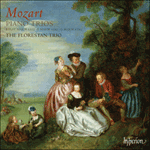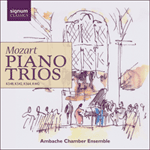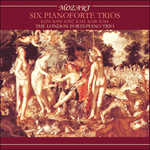
Welcome to Hyperion Records, an independent British classical label devoted to presenting high-quality recordings of music of all styles and from all periods from the twelfth century to the twenty-first.
Hyperion offers both CDs, and downloads in a number of formats. The site is also available in several languages.
Please use the dropdown buttons to set your preferred options, or use the checkbox to accept the defaults.
Indeed, this trio has a rather more ‘domestic’ feel than those Mozart wrote earlier in the year. It is simpler and shorter, perhaps aimed deliberately at the amateur market rather than for Mozart himself to play. Some writers have been disappointed to find this lighter work at the end of Mozart’s sequence of trios, and it is true that it says what it has to say without unnecessary complication. But Mozart at his most direct is just as difficult to play as Mozart at his most subtle and complex. He gives the impression of having put every note in precisely the right place, creating elegant and lyrical structures that require absolute clarity and precision. And if one imagines eavesdropping on friends playing at home, rather than the formality of concert presentation, this elegant and charming piece seems completely in its element.
The first movement is a fluent and rippling Allegro, with a second theme which is very closely related to the first, and a middle section that, rather than develop existing material, starts with an entirely new theme (as in the earlier two trios). These are examples of the subtle ways in which Mozart subverts expectations, even in an apparently straightforward piece of music. The Andante is a set of variations on a melody almost like a slow minuet, though with a hint of sadness in the harmonies of its last few bars. And the finale opens with a naïve little tune in the dotted rhythm of a siciliano. Its very simplicity enables Mozart to suggest shifts of mood with the deftest of touches: a move to a minor key clouds the atmosphere while maintaining the lively rhythm; another episode swings the music into a peasant dance. And the ending is a delight, with the instruments answering each other in wistful counterpoint, suggesting, as so often in Mozart, that deeper thoughts were all the time lurking beneath the tranquil surface.
from notes by Robert Philip © 2006
De fait, ce trio a un relent plus «domestique» que ceux composés plus tôt cette année-là. Plus simple et plus court, il vise peut-être délibérément le marché amateur, et non plus Mozart. Certains auteurs ont été déçus de trouver en cet ultime trio une œuvre plus légère, et il est vrai qu’il dit ce qu’il a à dire sans complication inutile. Mais Mozart sous son jour le plus direct est tout aussi difficile à jouer que Mozart sous son jour le plus subtil et le plus complexe. Il donne l’impression d’avoir mis chaque note à la bonne place, créant ainsi des structures élégantes et lyriques qui requièrent une clarté et une précision absolues. Et si l’on s’imagine non en public d’un concert formel, mais en auditeurs indiscrets d’amis jouant chez eux, cette pièce charmante et élégante semble parfaitement dans son élément.
Le premier mouvement, un fluide et ondoyant Allegro, comprend un deuxième thème très étroitement affilié au premier et une section centrale qui, au lieu de développer un matériau existant, s’ouvre sur un thème entièrement nouveau (comme dans les deux trios précédents). Ce qui illustre la subtilité avec laquelle Mozart détourne les attentes, même dans une œuvre apparemment simple. L’Andante est une série de variations sur une mélodie qui est presque un menuet lent, malgré une nuance de tristesse dans les harmonies des dernières mesures. Puis le finale s’ouvre sur un petit air naïf, sis dans le rythme pointé d’une sicilienne. Sa simplicité même permet à Mozart d’insinuer des changements de climat par de fort habiles touches: un changement en mineur obscurcit l’atmosphère tout en maintenant la vivacité du rythme; un autre épisode mue la musique en une danse paysanne. La conclusion est, elle, un ravissement: les instruments se répondent en un contrepoint mélancolique, suggérant, comme si souvent chez Mozart, que de profondes pensées n’ont cessé de se tapir sous la surface tranquille.
extrait des notes rédigées par Robert Philip © 2006
Français: Hypérion
In der Tat ist dieses Trio von einem eher „häuslichen“ Gefühl durchdrungen als diejenigen, die Mozart früher im gleichen Jahr geschrieben hatte. Es ist schlichter und kürzer und war möglicherweise eher für den allgemeinen Hausgebrauch gedacht als für einen Pianisten, wie Mozart selbst. Manche Kommentatoren haben sich enttäuscht darüber geäußert, daß gerade dieses leichtere Werk die Reihe von Mozarts Trios abschließt, und tatsächlich entbehrt seine musikalische Aussage jeglicher unnötigen Kompliziertheit. Doch Mozart in seiner Einfachheit und Direktheit ist genauso schwer zu spielen wie Mozart voller Subtilität und Komplexität. Es entsteht der Eindruck, er habe jeden Ton genau richtig plaziert, wodurch elegante und lyrische Strukturen entstehen, die mit absoluter Transparenz und Genauigkeit gespielt werden müssen. Stellt man sich vor, musizierenden Freunden bei der Hausmusik zu lauschen statt im Konzertsaal zu sitzen, dann erscheint dieses elegante und ansprechende Stück ganz und gar in seinem Element.
Der erste Satz ist ein fließendes und plätscherndes Allegro mit einem zweiten Thema, das mit dem ersten sehr eng verwandt ist, und einem Mittelteil, der, statt existierendes Material zu entwickeln, wie schon bei den früheren beiden Trios mit einem vollkommen neuen Thema beginnt. Dies sind Beispiele dafür, wie Mozart sogar bei einem ansonsten ganz unkomplizierten Stück auf subtile Art und Weise die Erwartungen untergräbt. Beim Andante handelt es sich um Variationen auf eine einem langsamen Menuett ähnelnde Melodie, allerdings mit einem Hauch von Traurigkeit in den Harmonien der letzten Takte. Zur Eröffnung des Finales setzt der Komponist eine naive kleine Melodie mit dem punktierten Rhythmus eines Siciliano ein. Gerade diese Schlichtheit ermöglicht es Mozart, mit den geschicktesten Mitteln Stimmungswechsel anzudeuten: ein Wandel ins Moll trübt die Atmosphäre, während der lebhafte Rhythmus beibehalten wird; eine weitere Episode läßt die Musik in einen Bauerntanz umschwingen. Der Schluß ist ein reines Vergnügen: Die Instrumente antworten sich gegenseitig mit leicht wehmütigem Kontrapunkt, was nahelegt, daß—wie so oft bei Mozart—schon die ganze Zeit tiefere Gedanken unter der scheinbar ruhigen Oberfläche lauerten.
aus dem Begleittext von Robert Philip © 2006
Deutsch: Bettina Reinke-Welsh
 Mozart: Piano Trios K502, 542 & 564 Mozart: Piano Trios K502, 542 & 564‘These are beautifully judged performances, generally fleeter of foot, airier of texture and more intimate in tone with an ideal balance between the i ... ‘Superb execution … another feather in the Florestan Trio's cap’ (International Record Review)» More |
 Mozart: Piano Trios K548, 542 & 564 Mozart: Piano Trios K548, 542 & 564Teasing, flirtatious, tender, elusive, anguished, charming and magical are all words used by performer and classical specialist, Diana Ambache, to describe these three Mozart piano trios, written in his last three year.» More |
 Mozart: Six Piano Trios Mozart: Six Piano Trios |

